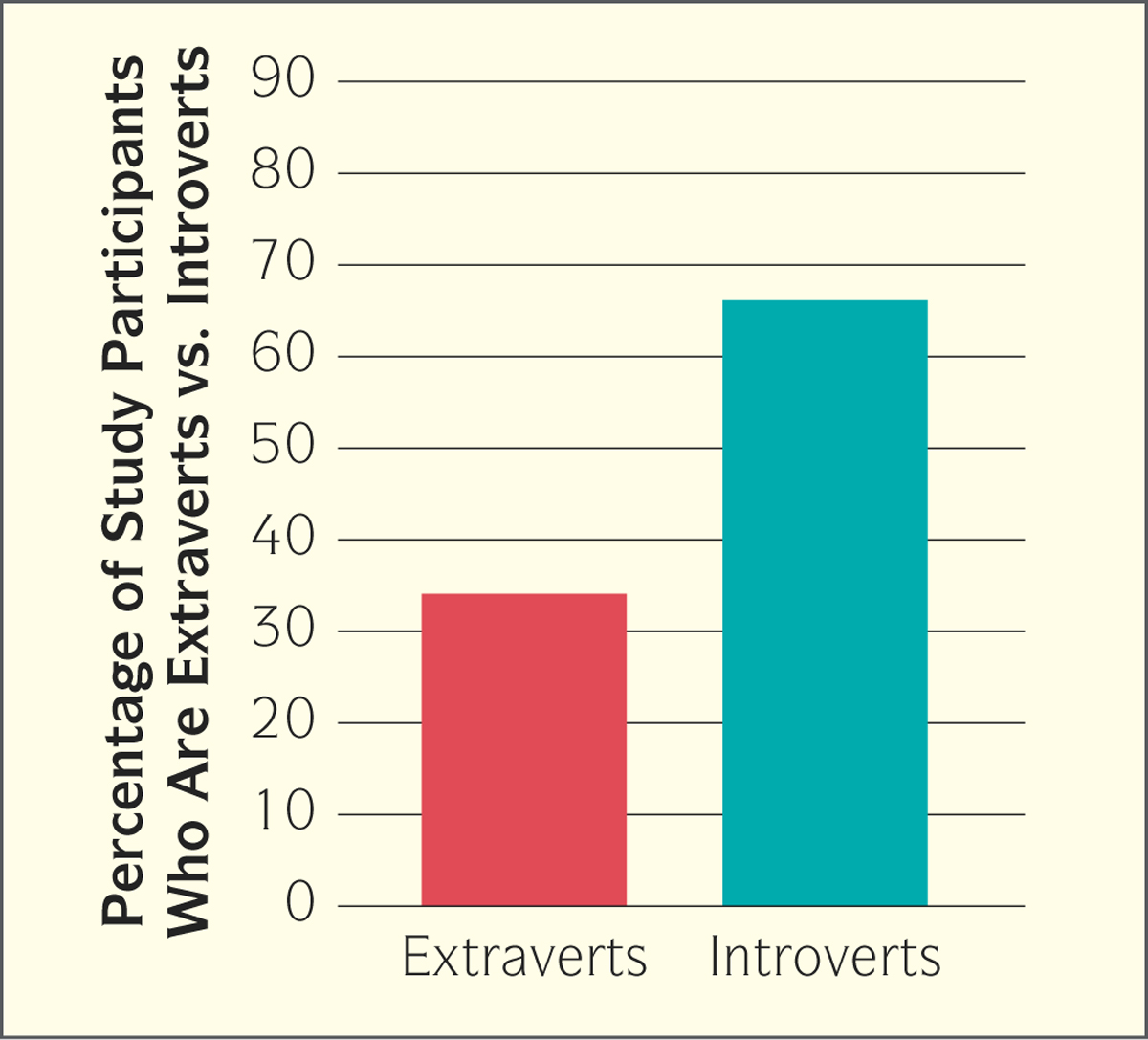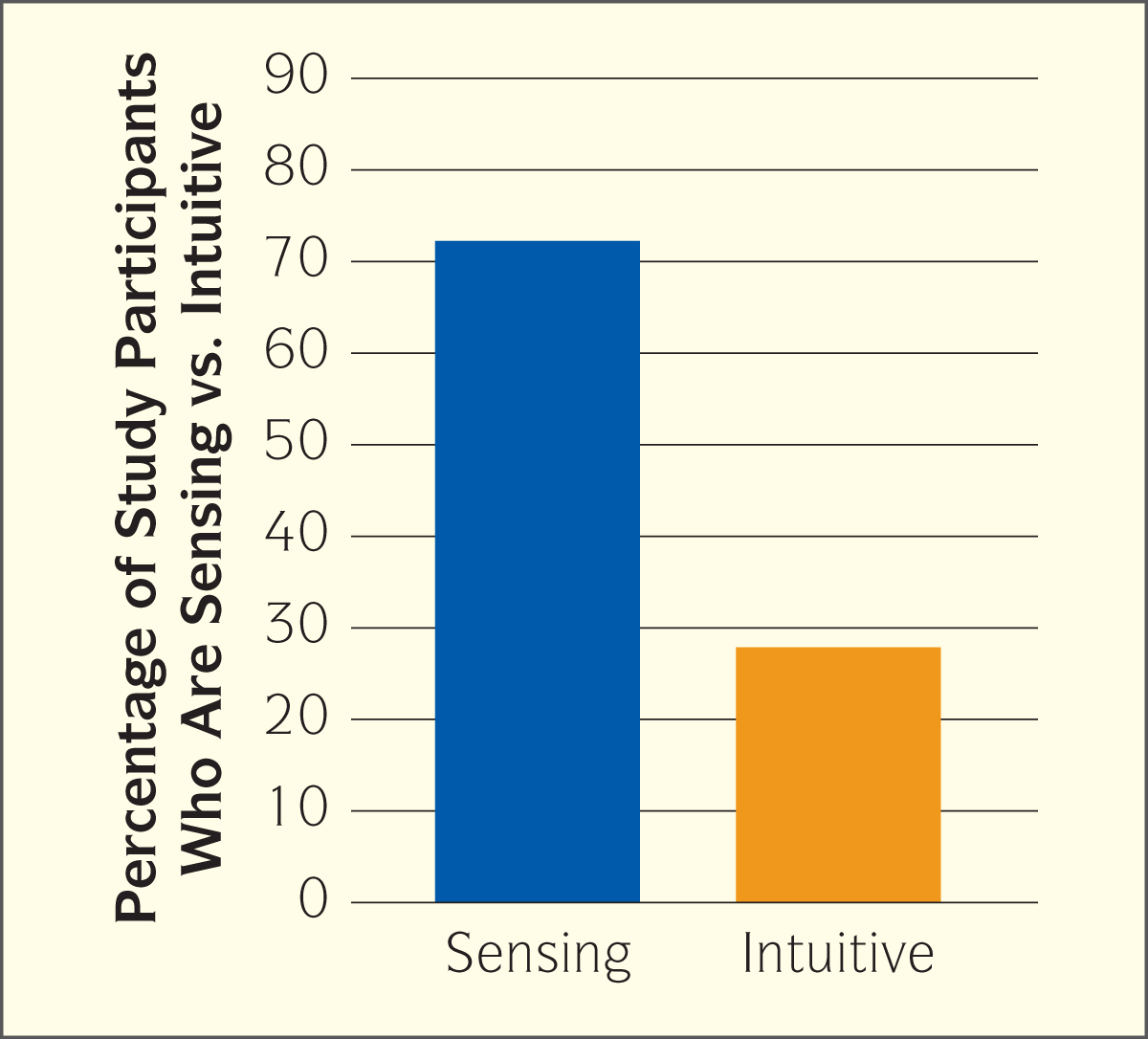Identify Your Learning Preferences
In the following sections, we explore two popular instruments for understanding how you prefer to learn: the Myers-Briggs Type Indicator (MBTI) and the VARK (Visual, Aural, Read-Write, and Kinesthetic) model. You can use each of these instruments, or both in combination, to identify your learning preferences. In fact, evaluating your results from both can give you valuable insights that can, in turn, help you develop effective learning strategies. As you read about both models, think about which preferences you identify with most. How might these preferences influence the way you tackle new and challenging material? How might they help explain why you like some classes more than others? How might understanding your preferences help you do well in classroom environments that challenge you to step outside your comfort zone?
Use the Myers-Briggs Model
Katharine Briggs and her daughter Isabel Myers created the Myers-Briggs Type Indicator (MBTI) based on the work of psychologist Carl Jung. In Jung’s theory, four dimensions of our personalities guide our behavior, influencing where we focus our energy, the kinds of information we prefer working with, how we make decisions, and how we organize our time and activities. Each of the four dimensions can be thought of as a continuum: Extravert/Introvert, Sensing/Intuitive, Thinking/Feeling, and Judging/Perceiving.1 As you read the following descriptions, consider where you fall on each dimension’s continuum. You may explore this content in even more detail if you take the MBTI in class or if it’s available at your campus career center.
FURTHER READING: For some examples of changing habits from introverted and extraverted perspectives, see “Introverts, Extroverts, and Habit Change,” by Meg Selig (Psychology Today, March 1, 2011).
78
Extravert/Introvert. The Extravert/Introvert dimension describes where you tend to focus your energy. Extraverts are action-oriented and like spending time with others. Being with people energizes them. Extraverts like Dylan, whom you read about at the beginning of the chapter, often learn best by interacting and discussing their learning with others or by applying their learning to real-life problems. Dylan’s preferred learning strategies may include forming study groups and working on group projects.
By contrast, Introverts are more thought-oriented and are energized by spending time alone. Introverts like Elizabeth prefer to learn through reflection and feel most comfortable discussing ideas once they’ve had a chance to think about them. Elizabeth can still work effectively in groups, but she may want time to process new information before she feels prepared to discuss it with others. Both Extraverts and Introverts can operate in their nonpreferred environments, but they may find it more draining than energizing.
CONNECT
TO MY EXPERIENCE
When you’re learning something new, do you focus on details and facts or on the big picture? Think about the advantages and disadvantages of each preference. Then, in writing, describe a time when focusing on details caused you to miss out on the big picture, or when focusing on the big picture caused you to overlook important details.
Sensing/Intuitive. The Sensing/Intuitive dimension relates to the kind of information you prefer working with: the details and facts or the big picture. Sensing learners prefer working with information as it comes to them through their senses. They love details and facts and have an easy time remembering and organizing such information. They choose to focus on “what is” rather than on “what might be,” and they enjoy making connections between seemingly unrelated pieces of information.
Sensing learners use the facts to build an understanding of the big picture. For example, Jonah isn’t sure what career he wants to pursue after graduation (the big picture). During his first two years at school, he chooses courses from the list of requirements and electives that interest him most. By the end of his second year, he sees that many of the courses he has gravitated toward concern human nature and relationships, such as psychology, sociology, and public health. Putting these details together, he concludes that he may enjoy careers in social work, psychotherapy, and health administration.
79
By contrast, Intuitive learners prefer to pay attention to facts and details only long enough to understand the big picture — the theory behind the concept or how the concept connects to other material. They focus on the possibilities (“what might be”) rather than on just the facts. They like to get an overview of a topic before digging into the specifics and want to know answers to broad questions such as “How does this topic relate to the last topic presented in class?”
Intuitive learners use the big picture to help themselves organize details and facts. For example, Leah has always seen herself going into some type of helping profession. Having this big picture in mind, she selects courses that specifically relate to these types of professions.


Thinking/Feeling. The Thinking/Feeling dimension relates to how you make decisions. Thinking decision makers prefer to use analysis and logic to arrive at a decision. By contrast, Feeling decision makers tend to make choices that maintain harmony or that demonstrate concern about human values and needs.
FOR DISCUSSION: Present to the class an article or a viral clip describing a recent current event. Ask students to share their reaction to the information provided. Was their reaction logical or emotional? Invite students to explore their initial response to see if they lean toward logical responses or emotional ones.
Take Tyler and Maria, who are in the same philosophy class, and are given an assignment to debate whether ethics or profits matter more in business. As a Thinking decision maker, Maria chooses to gather data, consider the pros and cons of both sides, and present an argument that making a profit is the primary goal in business and leads to social good. Tyler, who is a Feeling decision maker, chooses to focus on how a business’s decisions affect the well-being of people and communities. He prepares a more emotional argument that putting ethics at the forefront of business can lead to more profitable operations.

80
Being a Thinking or a Feeling learner can influence how you react during the various steps in the decision-making process (see the chapter on motivation, decision making, and personal responsibility). When evaluating the available options and weighing the pros and cons of each alternative, Thinkers may focus on the option that has more pros, while Feelers may concentrate on how the decision will affect the important people in their lives.
Judging/Perceiving. The Judging/Perceiving dimension describes how you organize your time and activities. Judging learners plan the details of their actions before proceeding, focus on actions that directly contribute to achievement of a goal or task, and generally have structured routines. They prefer making decisions and sticking with them and like to complete one project before starting another.
Perceiving learners are more comfortable taking action without first developing a plan. They multitask and juggle different projects at once, and prefer keeping their options open rather than committing to a decision.
When you study organization and time management in the corresponding chapter of this textbook, you may get a better sense of where your organizational preferences lie on this dimension. If you’re a Judger, you’ll likely appreciate the material on scheduling in that chapter. If you’re a Perceiver, you may cringe at the thought of organizing your life so systematically.
Your Preferences. Now that you’re familiar with the four dimensions of the MBTI (see Table 4.1 for a review), take a moment to record where you think you fall on each dimension. Using Figure 4.1 as a model, create a Myers-Briggs self-rating chart and place an X on each line to designate your preference and how strong you think it is. For example, an X far to the right on the Extravert/Introvert line would indicate that you have a strong Introvert preference, while an X far to the left would show a strong Extravert preference. An X somewhere in the middle would suggest a more moderate or a neutral preference. To download a copy of this chart, click here.
ACTIVITY: A number of MBTI-style assessments are offered online for free. In addition to completing the chapter’s self-rating activity, encourage students to use a search engine to find these free assessments outside of class. Remind your students that these assessments are informal and should be used only as a guide for better understanding themselves and discussing their preferences in class.

| Extravert/Introvert: Where you focus your energy |
|---|
|
E: Externally in the world of people |
|
I: Internally in your head |
| Sensing/Intuitive: The kind of information you prefer working with |
|
S: Facts and details |
|
N: The big picture |
| Thinking/Feeling: How you make decisions |
|
T: Analysis and logic |
|
F: Human values and needs |
| Judging/Perceiving: How you organize your time and activities |
|
J: Planned actions and structured routines |
|
P: Action taken without a plan, options kept open |
81
EXAMINING MBTI DIFFERENCES IN ONLINE LEARNERS
spotlight onresearch
Are you taking an online course? If so, you know that the online educational experience differs from the traditional face-to-face experience. For example, in an online course you use technology to exchange ideas, rather than talk in person with your instructor and classmates. You also have time to reflect as you formulate responses to discussion postings.


Because online and traditional learning environments differ, do students who choose to take online courses have different learning preferences than students who don’t? To answer this question, Dr. Davison Mupinga and his colleagues examined the Myers-Briggs types of 131 students enrolled in online courses in the Department of Industrial Technology at Indiana State University. They found that twice as many Introverts and almost three times as many Sensing learners enrolled in these courses, compared to Extraverts and Intuitives. This suggests that the vast majority of students in these online courses prefer having time alone to reflect on course content, and they prefer learning that focuses on factual information rather than on the big picture.
What do these results mean for you? Understanding your preferences will help you assess which learning environments you’ll feel more and less comfortable in. However, you shouldn’t avoid courses in learning environments where you’re less comfortable. Rather, the trick is to identify which environments are challenging and then actively seek out strategies that can help you succeed in those classes.
THE BOTTOM LINE
Understanding your learning preferences can help you find learning environments that best suit you — and succeed in environments where you’re less comfortable.
REFLECTION QUESTIONS
Question 4.1
1. Where do you think your preference lies on the Extravert–Introvert continuum? How does the strength of this preference influence your comfort level when interacting with others in face-to-face courses?
Question 4.2
2. Where do you think your preference lies on the Sensing–Intuitive continuum? How does the strength of this preference help explain your comfort level with details and facts versus theories and big concepts?
Question 4.3
3. If you’re taking an online course now, how has your experience been? If you’ve never taken an online course, what aspects of that environment do you think would be most enjoyable and most challenging for you?
D. M. Mupinga, R. T. Nora, and D. C. Yaw, “The Learning Styles, Expectations, and Needs of Online Students,” College Teaching 54 (2006): 185–89.
Use the VARK Model
The VARK is another model that can help you understand how you prefer to learn. Proposed by Neil Fleming, a high school and university teacher, the VARK describes what types of information people prefer to work with while learning.2 According to this model, learners have a preference for working with one or more of the following types of information: Visual, Aural (auditory), Read-Write, and Kinesthetic (hands-on, action-based). Many people feel comfortable working with more than one of these types of information. As you read the descriptions of each preference, consider which one(s) fit you best.
FURTHER READING: To learn more about the VARK model, visit the VARK Web site at www.vark-learn.com. The Web site includes frequently asked questions and study strategies for each of the learning preferences.
Visual (V). Visual learners prefer working with information that comes in such forms as charts, diagrams, maps, and graphs. They may translate material presented in class into concept maps, flowcharts, or other graphic forms to better understand course concepts and see how they relate to each other. For example, Marla, a Visual learner, made a map of concepts and arguments related to vegetarianism in her health class. The map helped her understand and organize various aspects of this lesson, including the history of vegetarianism; health, economic, environmental, and moral reasons for choosing this lifestyle; and possible health benefits and dangers associated with it.
FOR DISCUSSION: Present this scenario to the class: You just purchased a new dresser from a Swedish furniture store. In the showroom the dresser looked wonderful, but it’s now sitting in your living space in about two hundred pieces. What is your first step? Do you dive right in and start putting it together, or do you read the instructions? What does this say about your learning preferences?
Aural (A). Aural learners prefer working with information that comes in auditory forms, such as lectures, podcasts, and discussions with others. For instance, after listening to a lecture in her health class, Shoko talked about what she was learning with her vegetarian friend Becca. Through this conversation she found out why Becca decided to give up meat and what health benefits she experienced as a result of her choice.
82
83

Read-Write (R). Read-Write learners prefer learning from the written word. They may read a lot, use text-heavy slide presentations, and seek out books and journal articles using popular online sources such as Google Scholar. They may prefer to study by rereading important material, revising and reorganizing class notes, or preparing brief written responses to anticipated essay questions. Mateo, for example, decided to supplement the lecture on vegetarianism by reviewing Web sites and books on the topic in the college library. In these resources he learned more about the practice of vegetarianism in various religions, a topic that the lecture covered only briefly. These written resources reinforced material presented in the lecture and extended his learning in ways he found interesting.
Kinesthetic (K). Kinesthetic learners prefer experience and practice as a means of learning. They learn by doing or by watching others, and they enjoy watching demonstrations, trying their hand at simulations, and analyzing case studies. For example, Terrell decided to interview different types of vegetarians, including vegans and macrobiotics. After conducting these interviews, he spent a week on a vegan diet to see if he could detect any health-related benefits and challenges.
The VARK Questionnaire. Now that you understand the VARK model, you can assess your preferences using the VARK dimensions. Take a few minutes to complete the VARK Questionnaire and score your assessment. Select all the answers that apply to you; you can choose more than one response per question, or you can leave the question blank if none of the responses apply to you.
Keep in mind that your score in each learning preference category (V, A, R, and K) represents the strength of your preference for that type of information. Some students have clear preferences (for example, V = 11, A= 3, R = 1, K = 1), while other students’ preferences are more evenly distributed (for instance, V = 2, A = 1, R = 6, K = 7).
ACTIVITY: Put students into groups based on their VARK preferences. Ask each group to teach the class how to make a peanut butter and jelly sandwich (or some other basic task) using their dominant preference. You may wish to plan ahead by bringing in materials specific to your chosen task.
Once you have your results, reflect on them. What is your highest score? Does that learning preference make sense to you, based on your understanding of yourself? Do you have two or three scores that are relatively close together? If so, what are they? Do you use learning strategies from each of these categories?
84
VARK Questionnaire
You are helping someone who wants to go to your airport, the center of town, or a railway station. You would:
go with her.
tell her the directions.
write down the directions.
draw, or show her a map, or give her a map.
A Web site has a video showing how to make a special graph. There is a person speaking, some lists and words describing what to do, and some diagrams. You would learn most from:
seeing the diagrams.
listening.
reading the words.
watching the actions.
You are planning a vacation for a group. You want some feedback from them about the plan. You would:
describe some of the highlights they will experience.
use a map to show them the places.
give them a copy of the printed itinerary.
phone, text, or e-mail them.
You are going to cook something as a special treat. You would:
cook something you know without the need for instructions.
ask friends for suggestions.
look on the Internet or in some cookbooks for ideas from the pictures.
use a cookbook where you know there is a good recipe.
A group of tourists wants to learn about the parks or wildlife reserves in your area. You would:
talk about, or arrange a talk for them about, parks or wildlife reserves.
show them maps and Internet pictures.
take them to a park or wildlife reserve and walk with them.
give them a book or pamphlets about the parks or wildlife reserves.
You are about to purchase a digital camera or mobile phone. Other than price, what would most influence your decision?
Trying or testing it.
Reading the details or checking its features online.
It is a modern design and looks good.
The salesperson telling me about its features.
Remember a time when you learned how to do something new. Avoid choosing a physical skill, e.g., riding a bike. You learned best by:
watching a demonstration.
listening to somebody explaining it and asking questions.
diagrams, maps, and charts — visual clues.
written instructions — e.g., a manual or book.
You have a problem with your heart. You would prefer that the doctor:
gave you something to read to explain what was wrong.
used a plastic model to show what was wrong.
described what was wrong.
showed you a diagram of what was wrong.
You want to learn a new program, skill, or game on a computer. You would:
read the written instructions that came with the program.
talk with people who know about the program.
use the controls or keyboard.
follow the diagrams in the book that came with it.
I like Web sites that have:
things I can click on, shift, or try.
interesting design and visual features.
interesting written descriptions, lists, and explanations.
audio channels where I can hear music, radio programs, or interviews.
Other than price, what would most influence your decision to buy a new non-fiction book?
The way it looks is appealing.
Quickly reading parts of it.
A friend talks about it and recommends it.
It has real-life stories, experiences, and examples.
You are using a book, CD, or Web site to learn how to take photos with your new digital camera. You would like to have:
a chance to ask questions and talk about the camera and its features.
clear written instructions with lists and bullet points about what to do.
diagrams showing the camera and what each part does.
many examples of good and poor photos and how to improve them.
Do you prefer a teacher or a presenter who uses:
demonstrations, models, or practical sessions.
question and answer, talk, group discussion, or guest speakers.
handouts, books, or readings.
diagrams, charts, or graphs.
You have finished a competition or test and would like some feedback. You would like to have feedback:
using examples from what you have done.
using a written description of your results.
from somebody who talks it through with you.
using graphs showing what you had achieved.
You are going to choose food at a restaurant or cafe. You would:
choose something that you have had there before.
listen to the waiter or ask friends to recommend choices.
choose from the descriptions in the menu.
look at what others are eating or look at pictures of each dish.
You have to make an important speech at a conference or special occasion. You would:
make diagrams or get graphs to help explain things.
write a few key words and practice saying your speech over and over.
write out your speech and learn from reading it over several times.
gather many examples and stories to make the talk real and practical.
85
The VARK Questionnaire, Version 7.8. Copyright © 2014 held by Neil D. Fleming, Christchurch, New Zealand. Used by permission.
Your VARK Score
Use the following scoring chart to find the VARK category that each of your answers corresponds to. Circle the letters that correspond to your answers. For example, if you answered B and C for question 3, circle V and R in the question 3 row.
| Responses to Question 3: | A | B | C | D |
| VARK letter | K |

|

|
A |
| Question | A category | B category | C category | D category |
|---|---|---|---|---|
| 1. | K | A | R | V |
| 2. | V | A | R | K |
| 3. | K | V | R | A |
| 4. | K | A | V | R |
| 5. | A | V | K | R |
| 6. | K | R | V | A |
| 7. | K | A | V | R |
| 8. | R | K | A | V |
| 9. | R | A | K | V |
| 10. | K | V | R | A |
| 11. | V | R | A | K |
| 12. | A | R | V | K |
| 13. | K | A | R | V |
| 14. | K | R | A | V |
| 15. | K | A | R | V |
| 16. | V | A | R | K |
MY HIGHEST SCORES
Total number of Vs circled = _______________
Total number of As circled = _______________
Total numberof Rs circled = _______________
Total numberof Ks circled = _______________
86